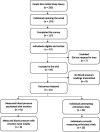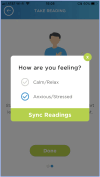A pilot study exploring novel contexts for out-of-office blood pressure measurement
- PMID: 38464843
- PMCID: PMC10920340
- DOI: 10.3389/fcvm.2024.1351746
A pilot study exploring novel contexts for out-of-office blood pressure measurement
Abstract
Introduction: Out-of-office blood pressure (BP) monitoring is increasingly valuable in the diagnosis and management of hypertension. With advances in wearable BP technologies, the ability to gain insight into BP outside of traditional centers of care has expanded greatly.
Methods: Here we explore the usability of a novel, wrist-worn BP cuff monitor for out-of-office data collection with participants following digital cues rather than in-person instruction. Transmitted measurements were used to evaluate BP variation with the time of day and day of week, BP variation with mood, and orthostatic measurements.
Results: Fifty participants, with a mean age of 44.5 years, were enrolled and received the BP monitor. 82% of the participants transmitted data via the smartphone application, and the median wear time of the device during the 4-week study was 11 days (IQR 8-17).
Discussion: This prospective digital pilot study illustrates the usability of wearable oscillometric BP technology combined with digital cues via a smartphone application to obtain complex out-of-office BP measurements, including orthostatic vital signs and BP associated with emotion. 25 out of 32 participants who attempted orthostatic vital signs based on in-app instruction were able to do so correctly, while 24 participants transmitted BP readings associated with emotion, with a significant difference in BP noted between calm and stressed emotional states.
Keywords: blood pressure; digital medicine; hypertension; personalized medicine; prevention.
© 2024 Allinson, Mejia, Ariniello, Quer and Muse.
Conflict of interest statement
The authors declare that the research was conducted in the absence of any commercial or financial relationships that could be construed as a potential conflict of interest.
Figures






Similar articles
-
WATCH-BPM-Comparison of a WATCH-Type Blood Pressure Monitor with a Conventional Ambulatory Blood Pressure Monitor and Auscultatory Sphygmomanometry.Sensors (Basel). 2023 Oct 31;23(21):8877. doi: 10.3390/s23218877. Sensors (Basel). 2023. PMID: 37960576 Free PMC article.
-
Accuracy and User Acceptability of 24-hour Ambulatory Blood Pressure Monitoring by a Prototype Cuffless Multi-Sensor Device Compared to a Conventional Oscillometric Device.Blood Press. 2023 Dec;32(1):2274595. doi: 10.1080/08037051.2023.2274595. Epub 2023 Oct 26. Blood Press. 2023. PMID: 37885101
-
Automated device that complies with current guidelines for office blood pressure measurement: design and pilot application study of the Microlife WatchBP Office device.Blood Press Monit. 2008 Aug;13(4):231-5. doi: 10.1097/MBP.0b013e3283057a84. Blood Press Monit. 2008. PMID: 18635980
-
Comparing Automated Office Blood Pressure Readings With Other Methods of Blood Pressure Measurement for Identifying Patients With Possible Hypertension: A Systematic Review and Meta-analysis.JAMA Intern Med. 2019 Mar 1;179(3):351-362. doi: 10.1001/jamainternmed.2018.6551. JAMA Intern Med. 2019. PMID: 30715088 Free PMC article.
-
Digital hypertension towards to the anticipation medicine.Hypertens Res. 2023 Nov;46(11):2503-2512. doi: 10.1038/s41440-023-01409-5. Epub 2023 Aug 23. Hypertens Res. 2023. PMID: 37612370 Review.
Cited by
-
The Role of Wearable Devices in Blood Pressure Monitoring and Hypertension Management: A Systematic Review.Cureus. 2024 Dec 3;16(12):e75050. doi: 10.7759/cureus.75050. eCollection 2024 Dec. Cureus. 2024. PMID: 39749057 Free PMC article. Review.
References
LinkOut - more resources
Full Text Sources

